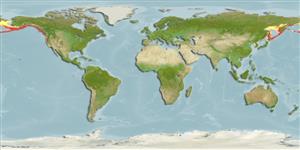Environment: milieu / climate zone / rango de profundidad / distribution range
Ecología
marino demersal; rango de profundidad 0 - 450 m (Ref. 58496). Temperate; 66°N - 34°N
North Pacific: Kamchatka, Russia and along the Commander and Aleutian Islands to St. Paul Island in the Bering Sea and to Monterey Bay, California, USA.
Tamaño / Peso / Age
Madurez: Lm ? range ? - ? cm
Max length : 51.0 cm TL macho / no sexado; (Ref. 2850); peso máximo publicado: 1.1 kg (Ref. 40637)
Short description
Claves de identificación | Morfología | Morfometría
Espinas dorsales (total) : 10 - 12; Radios blandos dorsales (total) : 18 - 20; Espinas anales: 0; Radios blandos anales: 13 - 16; Vértebra: 35. Dorsal with moderate notches in the spinous part after the third spine, and between the spinous and rayed parts; caudal bluntly rounded; pelvic fins larger in males (Ref. 6885). Color variable, predominately red, sometimes brilliant red, with brown, white, and black mottling and spotting all over; there are four irregular dark saddles across back; the caudal fin with darker rays, sometimes with vertical light bars; some large males with darkly spotted pelvic fins (including base of pectorals) (Ref. 6885).
Body shape (shape guide): elongated.
Usually near shore in rocky areas (Ref. 2850), from intertidal areas to 275 m depth (Ref. 6793). Adults feed on crabs, barnacles, and mussels (Ref. 6885). Good eating (Ref. 2850).
Life cycle and mating behavior
Madurez | Reproducción | Puesta | Huevos | Fecundidad | Larva
Eschmeyer, W.N., E.S. Herald and H. Hammann, 1983. A field guide to Pacific coast fishes of North America. Boston (MA, USA): Houghton Mifflin Company. xii+336 p. (Ref. 2850)
IUCN Red List Status (Ref. 130435: Version 2025-1)
Threat to humans
Harmless
Human uses
Pesquerías: comercial; pesca deportiva: si; Acuario: Acuarios públicos
Herramientas
Special reports
Download XML
Fuentes de Internet
Estimates based on models
Preferred temperature (Referencia
123201): 0.9 - 7.7, mean 4.4 °C (based on 386 cells).
Phylogenetic diversity index (Referencia
82804): PD
50 = 0.5156 [Uniqueness, from 0.5 = low to 2.0 = high].
Bayesian length-weight: a=0.00589 (0.00281 - 0.01234), b=3.15 (2.97 - 3.33), in cm total length, based on LWR estimates for this (Sub)family-body shape (Ref.
93245).
Nivel trófico (Referencia
69278): 3.5 ±0.6 se; based on diet studies.
Resiliencia (Referencia
120179): Muy bajo, población duplicada en un tiempo mínimo superior a 14 años (Preliminary K or Fecundity.).
Fishing Vulnerability (Ref.
59153): Moderate vulnerability (40 of 100).
🛈
